जुजुराना (Tragopan melanocephalus)(WesternTragopan)
भारत राज्य के राजकीय पक्षियों के क्रम को आगे बढ़ाते हुए आज चर्चा करते हैं, हिमाचल प्रदेश के राजकीय पक्षी की। यह बहुत ही खूबसूरत चिड़िया है, जिसका नाम जुजुराना (WesternTragopan) है। पश्चिमी ट्रैगोपन (Western Tragopan), जेवर या (western horned tragopan, Tragopan melanocephalus) या जुजुराना, उत्तर-पश्चिम हिमालय में पाए जाने वाला एक चमकीले पंखों वाला पक्षी है, जिसकी अनुमानित वैश्विक आबादी 3,500 से भी कम है। इसे 2007 में हिमाचल प्रदेश के राज्य पक्षी का दर्जा दिया गया था।
जुजुराना पक्षी के नर मादा में थोड़ा अंतर होता है। मादाओं के ऊपरी हिस्से हल्के भूरे-भूरे रंग के होते हैं, जो बारीकी से वर्मीकेटेड होते हैं और काले रंग के धब्बेदार होते हैं। अधिकांश पंखों पर काले धब्बे और केंद्रीय सफेद धारियाँ होती हैं। अपरिपक्व नर मादाओं से मिलते-जुलते हैं, लेकिन लंबे पैरों के साथ बड़े होते हैं और सिर पर अलग-अलग मात्रा में काला और गर्दन पर लाल रंग होता है।
नर बहुत गहरे, भूरे और काले रंग का होता है और उस पर कई सफेद धब्बे होते हैं, प्रत्येक धब्बे की सीमा गर्दन के किनारों और पीछे काले और गहरे लाल रंग के धब्बों से होती है। गला खुला है और त्वचा नीली है जबकि चेहरे की खुली त्वचा लाल है। उनके पास एक छोटी काली पश्चकपाल शिखा है।
नर का वजन 1.8-2.2 किलोग्राम (4.0-4.9 पाउंड) और मादाओं का वजन 1.25-1.4 किलोग्राम (2.8-3.1 पाउंड) होता है। नर की लंबाई 55-60 सेमी (22-24 इंच) होती है जबकि मादा की लंबाई 48-50 सेमी (19-20 इंच) होती है।
इन पक्षियों की पाकिस्तान में कोहिस्तान और काघन घाटी और भारत के किश्तवाड़, चंबा और कुल्लू जिलों के साथ-साथ भारत में सतलुज नदी के पूर्व के क्षेत्र से पांच आबादी ज्ञात है। वे 1,750 से 3,600 मीटर की ऊंचाई पर पाए जाते हैं, जो गर्मियों में और अधिक ऊंचाई पर पहुंच जाते हैं। उनका पसंदीदा निवास स्थान समशीतोष्ण, उप-अल्पाइन और चौड़ी पत्ती वाले जंगलों का घना मैदान है।
यह गर्मियों में 2,400 और 3,600 मीटर के बीच ऊपरी समशीतोष्ण जंगलों में रहता है, और सर्दियों में, 2,000 और 2,800 मीटर की ऊंचाई के बीच घने शंकुधारी और चौड़ी पत्ती वाले जंगलों में रहता है। पश्चिमी ट्रैगोपैन अधिकतर वृक्षीय है लेकिन जमीन पर भोजन के लिए उतरता है। वे ज्यादातर पत्तियों, अंकुरों और बीजों पर भोजन करते हैं, लेकिन कीड़े और अन्य अकशेरुकी जीवों का भी सेवन करते हैं। अधिकांश तीतरों की तरह, वे घोंसला बनाने के समय को छोड़कर पेड़ों पर अकेले या जोड़े में निवास करते हैं। वे मानवजनित अशांति के प्रति संवेदनशील हैं और अशांत आवासों (उदाहरण के लिए, जल-विद्युत परियोजना विकास स्थल) से बचते हैं।
पश्चिमी ट्रैगोपैन को सभी जीवित तीतरों में सबसे दुर्लभ माना जाता है। इसका दायरा बहुत सीमित है। कश्मीर घाटी में इसे डांगीर, चंबा में फुल्गर और कुल्लू घाटी में जुजुराना ("पक्षियों का राजा") के नाम से जाना जाता है। हिमाचल प्रदेश में लोग वेस्टर्न ट्रैगोपन ((Western Tragopan) को ‘पक्षियों का राजा’ भी कहते हैं। कश्मीर में इसे दानगीर (Dangir) के नाम से जाना जाता है।
पश्चिमी ट्रैगोपैन की आबादी को इसके पूरे क्षेत्र में कई मानवजनित कारकों से खतरा है। अनुमान है कि विश्व की आबादी 5,000 से कम है, जिसमें हिमाचल प्रदेश में बंदी प्रजनन आबादी भी शामिल है, जिसकी संख्या 2012 में दस जोड़े से भी कम थी। सीआईटीईएस ने इसके पंखों की बिक्री को हतोत्साहित करने के लिए इस प्रजाति को परिशिष्ट I में सूचीबद्ध किया है।
यह एक लुप्तप्राय पक्षी है और हिमालय पर्वतमाला के कारण भारत में हिमाचल प्रदेश के लिए थोड़ा विशिष्ट है। यह उत्तराखंड में भी पाया जाता है। अत्यधिक लुप्तप्राय प्रजातियों के कारण, हिमाचल प्रदेश ने जुजुराना (Jujurana) को वन्यजीव संरक्षण अधिनियम की अनुसूची I में रखा। जिससे इसकी रक्षा की जा सके।
English Translate
Jujurana (Tragopan melanocephalus)(WesternTragopan)
Taking forward the order of the state birds of the state of India, today we discuss about the state bird of Himachal Pradesh. This is a very beautiful bird, whose name is Jujurana (Western Tragopan). The Western Tragopan, Jewar or (western horned tragopan, Tragopan melanocephalus) or Jujurana, is a bright-winged bird found in the northwestern Himalayas, with an estimated global population of less than 3,500. It was given the status of the state bird of Himachal Pradesh in 2007.
There is little difference between male and female Jujurana bird. The upperparts of the females are pale greyish-brown, thinly vermiculated and speckled with black. There are dark spots and central white stripes on most of the wings. Immature males resemble females but are larger with longer legs and have varying amounts of black on the head and red on the neck.
The male is very dark, brown and black in color and has several white spots, each spot bordered by black and dark red spots on the sides and back of the neck. The throat is exposed and the skin is blue while the exposed skin of the face is red. They have a small black occipital crest.
Males weigh 1.8–2.2 kg (4.0–4.9 lb) and females weigh 1.25–1.4 kg (2.8–3.1 lb). Males are 55–60 cm (22–24 in) in length while females are 48–50 cm (19–20 in) in length.
Five populations of these birds are known from the Kohistan and Kaghan Valley in Pakistan and the Kishtwar, Chamba and Kullu districts of India, as well as the area east of the Sutlej River in India. They are found at altitudes of 1,750 to 3,600 metres, reaching higher altitudes in summer. Their preferred habitat is thickets of temperate, sub-alpine and broad-leaf forests.
It lives in upper temperate forests between 2,400 and 3,600 m in summer, and in winter, in dense coniferous and broad-leaf forests between 2,000 and 2,800 m altitude. The western tragopan is mostly arboreal but descends to the ground to feed. They feed mostly on leaves, shoots and seeds, but also consume insects and other invertebrates. Like most pheasants, they roost alone or in pairs in trees except during nesting time. They are sensitive to anthropogenic disturbance and avoid disturbed habitats (for example, hydro-electric project development sites).
The western tragopan is considered the rarest of all living pheasants. Its scope is very limited. It is known as Dangir in Kashmir Valley, Fulgar in Chamba and Jujurana ("King of Birds") in Kullu Valley. People in Himachal Pradesh also call Western Tragopan the 'King of Birds'. In Kashmir it is known as Dangir.
The western tragopan population is threatened by a number of anthropogenic factors throughout its range. The world population is estimated to be less than 5,000, including a captive breeding population in Himachal Pradesh, which numbered less than ten pairs in 2012. CITES has listed this species on Appendix I to discourage the sale of its fins.
It is an endangered bird and is a bit specific to Himachal Pradesh in India due to the Himalayan ranges. It is also found in Uttarakhand. Due to the highly endangered species, Himachal Pradesh placed Jujurana in Schedule I of the Wildlife Protection Act. So that it can be protected.
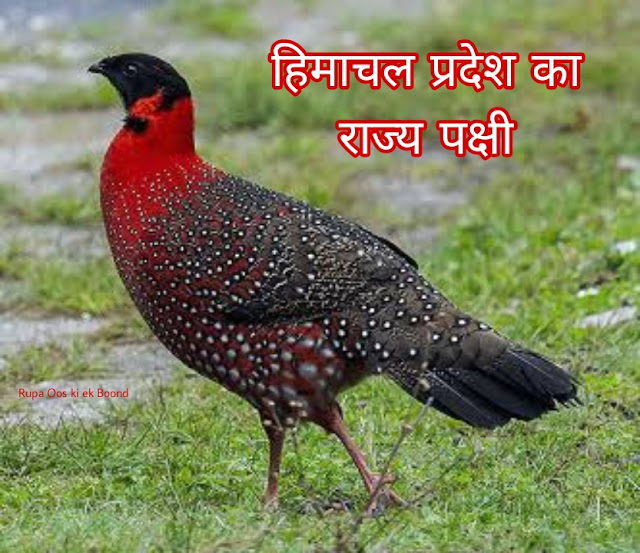
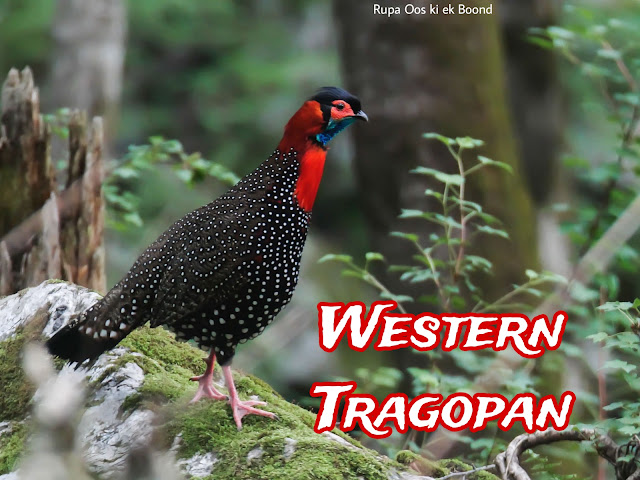
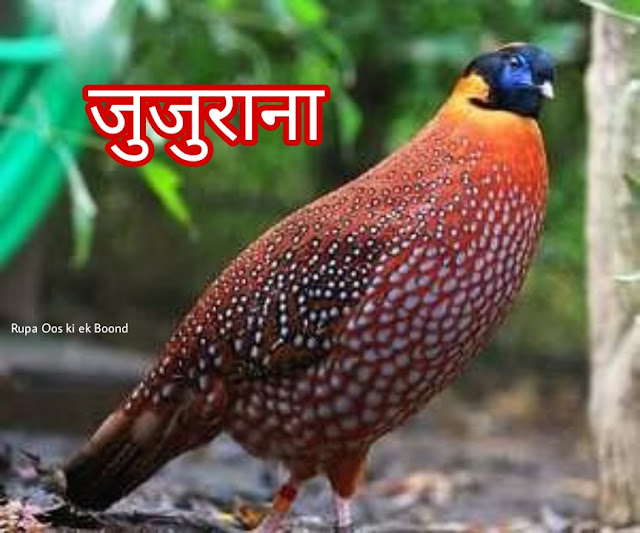
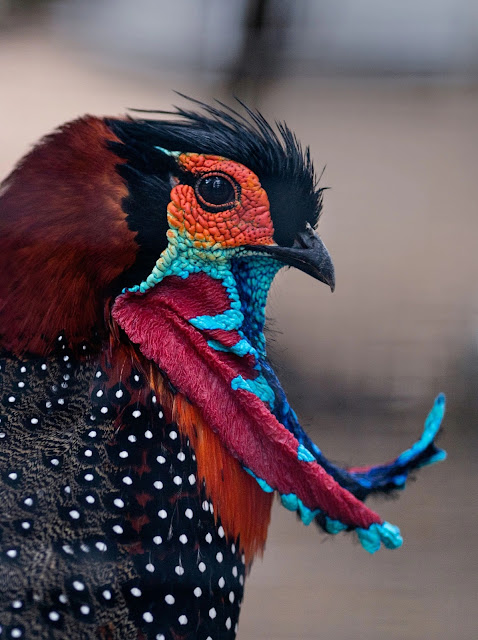
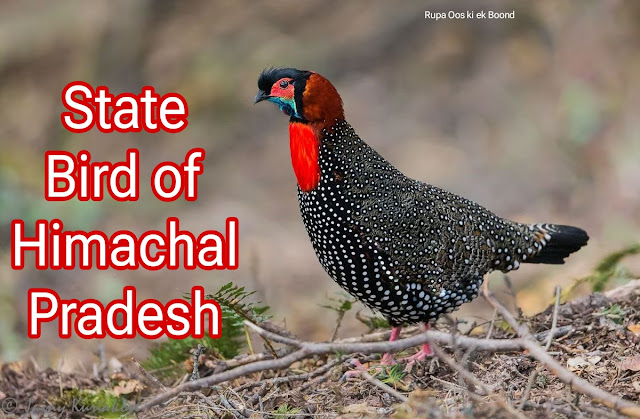
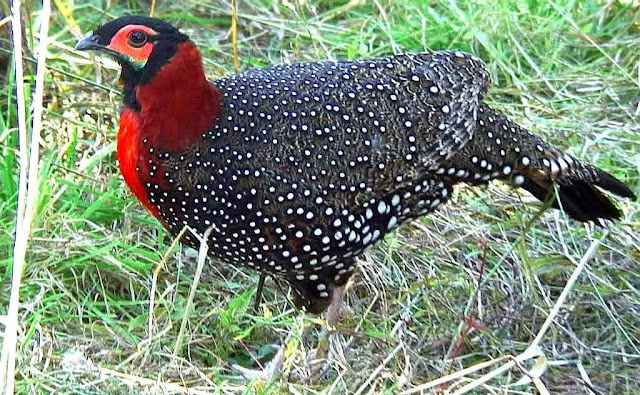
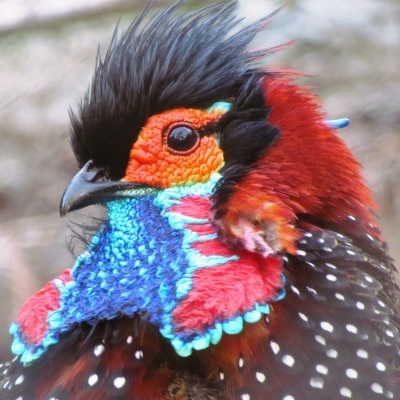

🙏🙏
ReplyDeleteविभिन्न प्रदेशों के राज्य पक्षियों के बारे में आप के ब्लॉग में अच्छी जानकारी मिल जाती है।
ReplyDeleteबहुत ही रोचक जानकारी देश और प्रदेश के दुर्लभ पंछियों के बारे में आपके द्वारा जानकारी प्राप्त हुईl
ReplyDeleteअच्छा पक्षी
ReplyDeletebeautiful bird
ReplyDeleteV nice
Very nice
ReplyDeleteअच्छी जानकारी
ReplyDeleteबहुत बढ़िया जानकारी
ReplyDeleteGood information
ReplyDelete🙏🙏💐💐शुभरात्रि 🕉️
ReplyDelete🙏जय जय सियाराम 🚩🚩🚩
👌👌अद्धभुत, रोचक व अच्छी जानकारी शेयर करने के लिए आपका बहुत बहुत धन्यवाद 💐💐
Very nice
ReplyDeleteअद्धभुत जानकारी
ReplyDeleteखूबसूरत पक्षी
ReplyDeleteबढ़िया जानकारी
Beautiful.
ReplyDelete